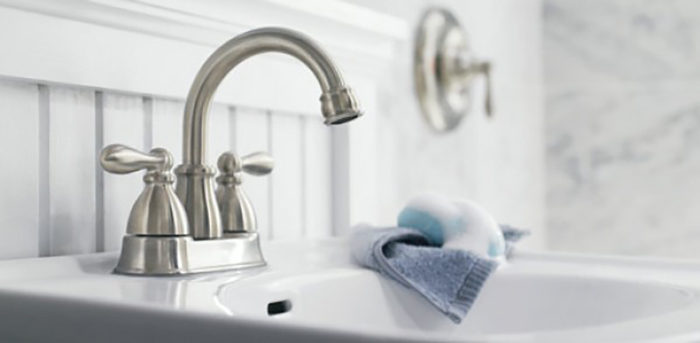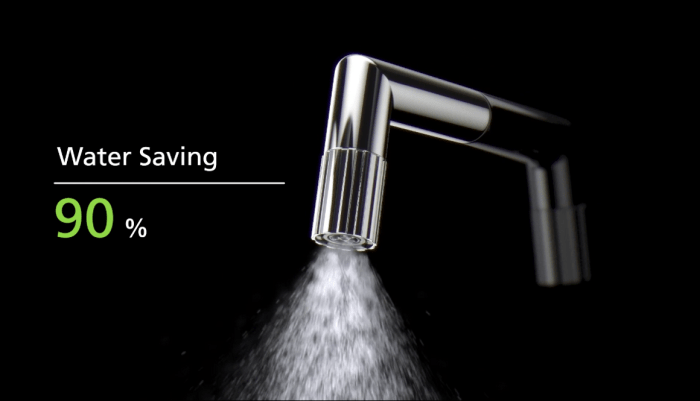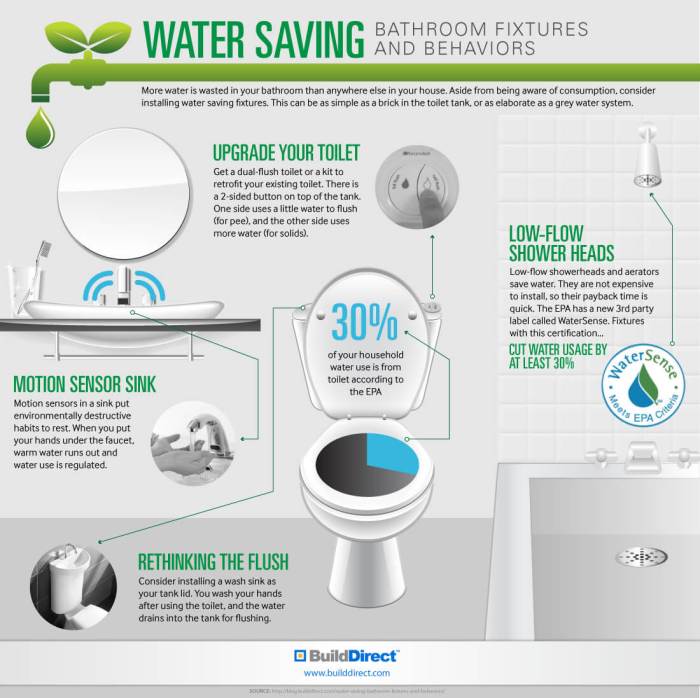In today’s world, water conservation is more important than ever. One area where we can make a significant impact is in our bathrooms. By installing water-saving bathroom fixtures, we can reduce our water consumption and utility bills, while also helping to protect the environment.
In this guide, we will discuss the benefits of water-saving bathroom fixtures, provide examples of different types of fixtures, and offer tips for installation and maintenance. We will also explore the cost and return on investment (ROI) of water-saving fixtures, as well as their environmental impact.
Water-Saving Bathroom Fixtures for Eco-Conscious Homeowners
Conserving water in our daily lives is essential, and the bathroom is one area where we can make a significant impact. Installing water-saving bathroom fixtures can help reduce our water consumption and protect this precious resource.
Water-saving bathroom fixtures are designed to use less water while maintaining functionality. They incorporate innovative technologies that optimize water flow and reduce waste without compromising performance.
Benefits of Water-Saving Bathroom Fixtures
- Reduced Water Consumption: These fixtures use less water, resulting in lower water bills and reduced strain on water resources.
- Energy Savings: Heating water requires energy, so using less water also reduces energy consumption.
- Environmental Sustainability: Conserving water helps protect water sources and ecosystems.
- Increased Water Pressure: Some water-saving fixtures can actually improve water pressure, enhancing the user experience.
Examples of Water-Saving Bathroom Fixtures
- Low-Flow Toilets: These toilets use less than 1.6 gallons per flush, compared to traditional toilets that use up to 3.5 gallons.
- Dual-Flush Toilets: These toilets offer two flush options, a full flush for solid waste and a half flush for liquid waste, further reducing water consumption.
- Low-Flow Showerheads: Showerheads with a flow rate of 2.5 gallons per minute or less can save significant amounts of water.
- Aerators: These devices mix air into the water stream, creating a fuller flow while using less water.
Types of Water-Saving Bathroom Fixtures
Toilets, faucets, and showerheads are the main water-consuming fixtures in a bathroom. Upgrading to water-saving models can significantly reduce water usage without compromising functionality or comfort.
Toilets
Toilets account for approximately 30% of household water consumption. Water-saving toilets use less water per flush, reducing water usage without sacrificing performance.
- Dual-flush toilets: Offer two flush options, a full flush for solid waste and a half flush for liquid waste, reducing water consumption by up to 50%.
- Low-flow toilets: Use a maximum of 1.6 gallons per flush (GPF), compared to older toilets that used up to 3.5 GPF.
- Ultra-low-flow toilets: Use even less water, typically around 1.28 GPF.
Faucets
Faucets are responsible for another 20% of bathroom water usage. Water-saving faucets reduce water flow without affecting water pressure.
- Low-flow faucets: Limit water flow to 1.5 gallons per minute (GPM), compared to standard faucets that use up to 2.2 GPM.
- Aerated faucets: Mix air into the water stream, creating a larger, fuller flow that feels like a higher water flow rate, while actually using less water.
- Sensor faucets: Turn on and off automatically when hands are detected, eliminating water waste.
Showerheads
Showerheads are the third major water-consuming fixture in bathrooms. Water-saving showerheads reduce water flow while maintaining a comfortable shower experience.
- Low-flow showerheads: Limit water flow to 2.5 GPM or less, compared to standard showerheads that use up to 5 GPM.
- High-efficiency showerheads: Use advanced technologies to optimize water flow and spray patterns, delivering a satisfying shower experience with even lower water usage.
- Multi-function showerheads: Offer multiple spray patterns, including low-flow options, allowing users to customize their shower experience while saving water.
Installation and Maintenance of Water-Saving Fixtures
Installing water-saving fixtures is crucial for eco-conscious homeowners. These fixtures not only conserve water but also reduce utility bills and contribute to environmental sustainability.
Installing Water-Saving Toilets
*
-*Choose the right toilet
Opt for toilets with a WaterSense label, indicating they meet specific water-saving criteria.
-
-*Measure the distance between the floor and the bottom of the toilet tank
This will help determine the appropriate size of the replacement toilet.
-*Turn off the water supply to the toilet
Use the shut-off valve behind the toilet.
-*Disconnect the water supply line and flush the toilet
This will drain any remaining water.
-*Remove the old toilet
Unscrew the bolts holding the toilet to the floor and carefully lift it off.
-*Install the new toilet
Place the new toilet in position and secure it with the bolts.
-*Reconnect the water supply line
Hand-tighten the connection and turn on the water supply.
-*Check for leaks
Flush the toilet and inspect for any leaks around the base or connections.
Maintaining Water-Saving Faucets and Showerheads
*
-*Clean aerators regularly
Remove the aerator from the faucet or showerhead and clean it with a toothbrush or vinegar solution.
-
-*Replace washers
Worn or damaged washers can cause leaks. Replace them with new ones as needed.
-*Tighten loose handles
Loose handles can cause water to drip. Tighten them using a wrench or screwdriver.
Troubleshooting Common Issues
*
-*Dripping faucets
Check for loose handles or worn washers. Tighten or replace as necessary.
-
-*Leaking showerheads
Replace the washer or o-ring inside the showerhead.
-*Low water pressure
Clean the aerator or check for clogs in the water supply line.
Cost and ROI of Water-Saving Fixtures
Installing water-saving bathroom fixtures can be a cost-effective investment for eco-conscious homeowners. The upfront cost may vary depending on the type of fixtures chosen and the complexity of installation, but the long-term savings on water and energy bills can be significant.
The return on investment (ROI) for water-saving fixtures can be calculated by comparing the cost of installation to the potential savings on water and energy bills. For example, a low-flow showerhead that costs $50 may save up to 2,000 gallons of water per year, which could translate to savings of $50-$100 on water bills.
Similarly, a high-efficiency toilet that costs $200 may save up to 10,000 gallons of water per year, resulting in savings of $100-$200 on water bills.
Government Incentives and Rebates
Many governments offer incentives and rebates to homeowners who install water-saving fixtures. These incentives can vary by region and may include tax credits, rebates, or free installation. Homeowners should check with their local government or utility companies to see if they qualify for any incentives.
Environmental Impact of Water-Saving Fixtures
Water-saving bathroom fixtures play a significant role in reducing water consumption, leading to several environmental benefits. These fixtures conserve water through various mechanisms, such as low-flow showerheads, aerated faucets, and dual-flush toilets, effectively decreasing the amount of water used for daily tasks.
Water conservation has a direct impact on the environment. It helps preserve water resources, reducing the strain on natural ecosystems and ensuring the availability of water for future generations. By conserving water, we can protect aquatic habitats, maintain healthy ecosystems, and mitigate the effects of water scarcity.
Impact on Water Scarcity
Water scarcity is a pressing issue affecting many regions globally. According to the World Economic Forum, by 2030, global demand for water is projected to exceed supply by 40%. Water-saving fixtures can help alleviate water scarcity by reducing household water consumption.
Studies have shown that low-flow showerheads can reduce water usage by up to 50%, while aerated faucets can save up to 30%. By adopting these fixtures, households can significantly contribute to water conservation and help address the challenges of water scarcity.
Design Considerations for Water-Saving Bathrooms
Creating a water-efficient bathroom involves thoughtful design and careful selection of fixtures. Here are some design ideas to consider:
- Low-flow toilets: These toilets use less water per flush, saving up to 30 gallons per day. Consider models with dual-flush options for further water conservation.
- Low-flow showerheads: Similar to low-flow toilets, these showerheads reduce water consumption by restricting the flow rate. They come in various styles and spray patterns to suit your preferences.
- Aerated faucets: Aerators mix air into the water stream, creating a fuller, more satisfying flow while reducing water usage. They are a simple and effective way to save water at the sink.
- Water-saving appliances: Consider incorporating water-saving appliances such as washing machines and dishwashers. These appliances use advanced technology to optimize water consumption during their cycles.
Incorporating Water-Saving Fixtures into Bathroom Renovations
When renovating your bathroom, it’s an ideal time to upgrade to water-saving fixtures. Here are some tips:
- Plan ahead: Determine your water-saving goals and research suitable fixtures before making purchases.
- Seek professional advice: Consult a plumber or bathroom designer for expert guidance on fixture selection and installation.
- Consider aesthetics: Water-saving fixtures are available in a wide range of styles and finishes to complement any bathroom design.
- Maximize space: Choose space-saving fixtures, such as wall-mounted toilets or compact showers, to optimize space while conserving water.
Aesthetic Appeal of Water-Saving Bathroom Fixtures
Water-saving bathroom fixtures not only reduce water consumption but can also enhance the aesthetics of your bathroom:
- Sleek and modern: Many water-saving fixtures feature contemporary designs that add a touch of sophistication to your bathroom.
- Variety of finishes: Fixtures are available in a range of finishes, including chrome, brushed nickel, and matte black, allowing you to match your bathroom’s existing décor.
- Eco-friendly appeal: Water-saving fixtures demonstrate your commitment to environmental sustainability, creating a positive impression on guests and potential buyers.
By incorporating water-saving design considerations into your bathroom, you can create a stylish and eco-conscious space that conserves water and reduces your environmental impact.
Case Studies and Success Stories
Numerous homeowners have experienced remarkable water savings and cost reductions by implementing water-saving bathroom fixtures. These case studies demonstrate the tangible benefits of these eco-conscious choices.
A homeowner in California installed low-flow showerheads and toilets, resulting in a 30% reduction in water consumption. This translated into an annual savings of over $100 on water bills.
Testimonials
Satisfied homeowners attest to the positive impact of water-saving bathroom fixtures:
“Our new low-flow showerhead feels just as refreshing, but we’ve noticed a significant decrease in our water usage.”
Sarah, homeowner
“Switching to water-saving toilets has made a huge difference in our water bills. We’re proud to contribute to environmental conservation.”John, homeowner
Last Point
By making the switch to water-saving bathroom fixtures, you can make a real difference in your water consumption and utility bills. You can also help to protect the environment and ensure that future generations have access to clean water. So what are you waiting for? Start saving water today!



